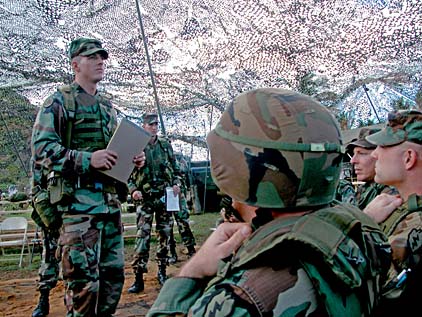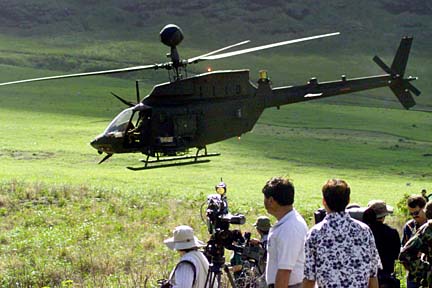
GREGG K. KAKESAKO / GKAKESAKO@STARBULLETIN.COM
The Army resumed live-fire training in Makua Valley yesterday. Sgt. Shannon Adkins, a 25th Division observer-controller, critiqued soldiers who underwent truck convoy ambush training in preparation for their year-long deployment to Afghanistan.
Army trains in
Makua Valley for
Iraqi ambushesLive-fire maneuvers strive for
realism but use no artillery
By the end of next week, nearly 1,200 Schofield Barracks soldiers will have completed live-fire training in Makua Valley designed to help them stay alive in Iraq and Afghanistan next year.
The exercises are the first time the Army has used live ammunition in the valley since July, when a planned burn raged out of control, charring half the valley and the rare plants that live there.
However, the training that began yesterday was done without the use of artillery cannons and mortars -- weapons the Army believes soldiers should be able to use but which opponents say caused past wildfires in the 4,190-acre valley.
Under an agreement reached Thursday with activist group Malama Makua and EarthJustice, the Army could resume live-fire training, but without artillery.
Maj. Frank Tate, who is in charge of training 150 soldiers from the 25th Infantry Division Aviation Brigade, said this week's training scenario is "very realistic, and we are able to work within the guidelines ... but we would still like to use all of our weapons to better prepare our soldiers."
The new training agreement was needed because the Army wanted to amend a previous pact on the way it uses the Leeward Oahu facility by adding truck convoy operations -- favorite targets for Iraqi guerrillas.
Typically the soldiers in the division's aviation brigade do not move about in truck convoys, but rely on their helicopters, Tate told reporters. However, he said Army leaders are requiring all soldiers deploying to Southwest Asia to get this type of training.
CRAIG T. KOJIMA / CKOJIMA@STARBULLETIN.COM
A Kiowa Warrior armed reconnaissance helicopter flew low to the ground, and to a media crew, in support of convoy trucks.
"The enemy in Iraq will not attack us at the sharp end of the spear," Tate said, but has chosen repeatedly to hit "soft targets."
"Our goal is to make sure they are wrong when they attack our rear echelons," Tate said. "They will find them well trained and well protected."
This week, nearly 600 soldiers from the Aviation Brigade will practice defending themselves while being transported in 5-ton trucks. Next week, the same training scenario will be repeated with nearly 600 soldiers of the 25th Division's Support Command.
Yesterday, two OH-58 Kiowa helicopters provided cover above a convoy of three trucks, each carrying 14 soldiers up the valley's dirt road.
Sgt. Rico Colon, a member of Headquarters Troop, said in Afghanistan the bed of the truck would be lined with a Kevlar blanket to protect it from mines.
Traveling at about 5 mph, seven soldiers on one side of the truck peppered pop-up targets with M-16 ammunition.
The exercise is to teach soldiers "to produce a high volume of well-aimed shots," Tate said.
CRAIG T. KOJIMA / CKOJIMA@STARBULLETIN.COM
Protesters outside the gate at Makua Cave included Chablis Gaspar, left, and Kyle Kajihiro.
"The idea is to get out of the area as quickly as possible. ... It also is to teach drivers that they also have to be disciplined and concentrate on what they are doing."
The exercises were closely observed by David Henkin, EarthJustice attorney.
"The only real issue was that the Army didn't have markers indicating the right and left lines of fires (boundaries)," Henkin said after the exercises.
"I am keeping my fingers crossed" that with safeguards in place, the scores of cultural sites and the 40 endangered species in the valley will be protected, he said.
Outside of the gate to Makua Military Reservation, nearly two dozen protesters held signs and placards, blasting a loud siren each time a vehicle tried to get into the training area.
Tate said the Army's fire safety prevention measures included stationing a Black Hawk helicopter, equipped with a 660-gallon fire bucket, near a dip pond with another one on standby at Wheeler Army Air Field. Also on standby was a federal firefighting crew, two all-terrain Army Humvee firetrucks and a 20-man firefighting detail.


